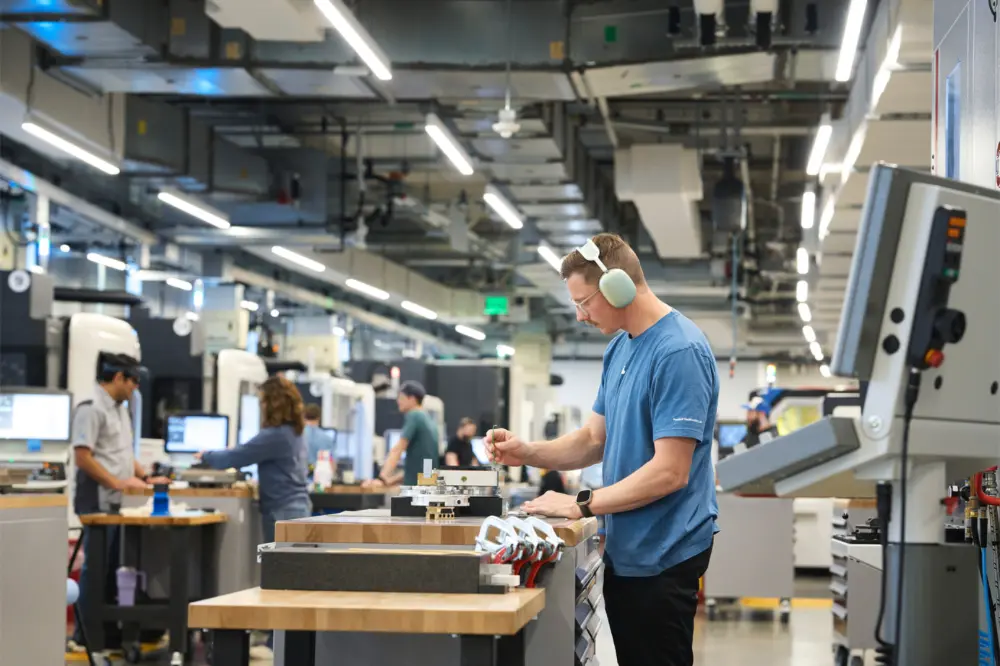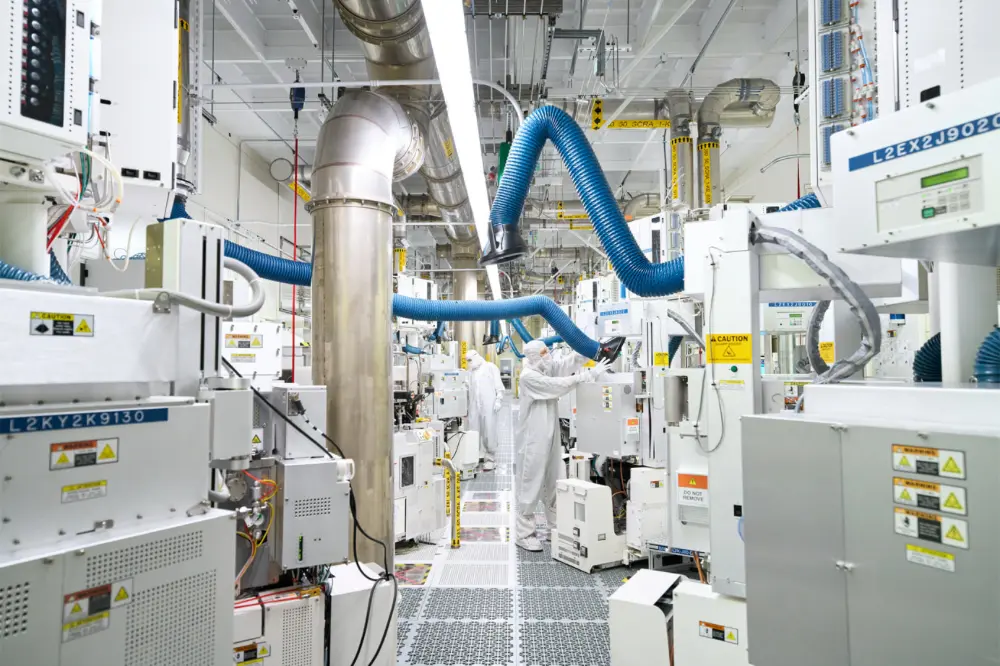Apple recently announced its plans to spend and invest more than $500 billion in the U.S. over the next four years.
The investment represents the technology company’s largest-ever spend commitment, according to a press release they issued announcing the news.
“We are bullish on the future of American innovation, and we’re proud to build on our long-standing U.S. investments with this $500 billion commitment to our country’s future,” said Tim Cook, Apple’s CEO. “From doubling our Advanced Manufacturing Fund, to building advanced technology in Texas, we’re thrilled to expand our support for American manufacturing. And we’ll keep working with people and companies across this country to help write an extraordinary new chapter in the history of American innovation.”
As part of this broader investment initiative in the U.S., Apple and its partners will establish a new state-of-the-art manufacturing facility in Houston to build servers that power Apple Intelligence—the company’s personal artificial intelligence platform designed to help users write, create, and accomplish tasks with ease. In addition, Apple will double the size of its U.S. Advanced Manufacturing Fund, launch a new training academy in Michigan to develop future American manufacturing talent, and expand its U.S. R&D efforts to drive innovation in cutting-edge areas like silicon engineering.

This $500 billion commitment encompasses Apple’s collaborations with thousands of suppliers in all 50 states, its direct workforce, infrastructure and data centers supporting Apple Intelligence, corporate campuses, and Apple TV+ productions active in 20 states. Apple continues to be one of the nation’s largest taxpayers, having contributed over $75 billion in U.S. taxes in the last five years—$19 billion of that in 2024 alone.
Today, Apple helps support over 2.9 million jobs across the United States through its direct employment, partnerships with domestic suppliers and manufacturers, and the growing ecosystem of developers in the iOS app economy.
Apple’s New Houston Manufacturing Facility
As part of its latest wave of U.S. investments, Apple will partner with manufacturers to begin assembling servers in Houston later this year. A new 250,000-square-foot facility dedicated to server production is scheduled to open in 2026, creating thousands of new jobs in the region.
These servers, which were previously built overseas, play a critical role in enabling Apple Intelligence and form the backbone of Private Cloud Compute—a system that fuses powerful AI performance with what Apple says is the most advanced security framework ever implemented at scale for AI in the cloud.
These servers reportedly lower the power demands of its data centers, all of which are already powered by 100 percent renewable energy. As Apple rolls out Apple Intelligence to users across the country, it also plans to continue expanding its data center footprint in North Carolina, Iowa, Oregon, Arizona, and Nevada.
Apple to Double its U.S. Advanced Manufacturing Fund
As part of this expanded investment effort, Apple is doubling its U.S. Advanced Manufacturing Fund—from $5 billion to $10 billion. Originally launched in 2017 to foster innovation and high-skilled manufacturing jobs nationwide, the enhanced fund will continue driving advanced manufacturing and workforce development across the country.
This expansion includes a multibillion-dollar investment in advanced silicon production at TSMC’s Fab 21 facility in Arizona, where Apple is the largest customer. The cutting-edge plant employs more than 2,000 people and began mass-producing Apple chips last month, marking a major milestone in bringing chip manufacturing to the U.S.
Apple says it designs its silicon to deliver top-tier performance, energy efficiency, and powerful features across its devices. Today, Apple suppliers manufacture silicon components in 24 facilities across 12 states—including Arizona, Colorado, Oregon, and Utah. According to Apple’s press release, these investments fuel thousands of high-paying jobs at American companies such as Broadcom, Texas Instruments, Skyworks, and Qorvo.
So far, Apple’s U.S. Advanced Manufacturing Fund has supported initiatives in 13 states—including Kentucky, Pennsylvania, Texas, and Indiana—helping strengthen local economies, equip workers with valuable skills, and advance a broad range of innovative manufacturing techniques and materials used in Apple products.

Growing Investments in R&D
Apple is continuing to scale its research and development efforts across the United States. Over the past five years, the company has nearly doubled its domestic investment in advanced R&D and plans to further increase that spending as part of its long-term growth strategy.
The company recently unveiled the iPhone 16e, the latest addition to its smartphone lineup. The device features the A18 chip and the newly introduced Apple C1, a cellular modem designed in-house. Apple says the C1 offers improved power efficiency and marks a shift toward designing more of its own modem systems. The modem is the product of multiple years of development and signals the company’s intent to further integrate its silicon architecture across future devices.
Looking ahead, Apple has announced plans to hire approximately 20,000 new employees over the next four years, with most of those roles centered on research and development, silicon engineering, software, artificial intelligence, and machine learning. As part of this effort, the company will continue expanding its R&D footprint across various U.S. hubs, with teams focused on areas such as custom chip design, hardware, and emerging software technologies.
New Manufacturing Academy in Detroit
Apple plans to launch a new Apple Manufacturing Academy in Detroit aimed at helping businesses adopt advanced manufacturing practices. The initiative will bring together Apple engineers and academic experts, including faculty from Michigan State University, to advise small and mid-sized companies on integrating AI and smart manufacturing technologies. The academy will offer free courses—both in-person and online—covering topics such as project management and manufacturing process optimization, with the goal of improving efficiency, productivity, and quality across supply chains.
The company’s broader investment in workforce development includes ongoing support for educational programs targeting U.S. students and workers. That includes grants for national organizations such as 4-H, Boys & Girls Clubs of America, and FIRST, which collaborate with Apple to provide free skill-building opportunities in local communities—particularly in areas like coding and STEM education. Among its other initiatives, Apple’s New Silicon Initiative is designed to prepare students for careers in chip design and hardware engineering. Originally launched at Georgia Tech, the program has since expanded to eight institutions nationwide and will add a new partnership this year with UCLA’s Center for Education of Microchip Designers (CEMiD).
GPRS Intelligently Visualizes The Built World® for customers in the construction, remodel & design-build industries.
What can we help you visualize?
Frequently Asked Questions
Can GPRS handle projects at a national scale?
Absolutely. GPRS has a coast-to-coast team of highly trained, SIM-certified Project Managers, covering all 50 states—including Alaska, Hawaii—and even Puerto Rico. Our teams are frequently engaged in large-scale projects across sectors like energy, retail, environmental services, healthcare, education, infrastructure, and a broad range of industries tied to architecture, engineering, and construction.
You can explore more about GPRS’ national reach here.
How does GPRS manage data delivery for large regional or national projects?
No matter the scale—from a single utility locate to thousands of miles of infrastructure—GPRS ensures every client receives consistent, high-quality service and deliverables. That’s the foundation of SiteMap® (patent pending), our proprietary interactive software platform. Every client is granted free access to SiteMap® Personal, and we also offer tailored SiteMap® solutions for anything from an individual job site to a comprehensive, nationwide facilities portfolio.
